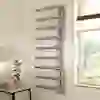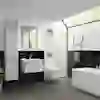Share:
The extractor fan is an essential household appliance for many homes, not just in our bathrooms but also in our kitchens. Helping to clear the air and keep the humidity levels balanced, extractor fan designs keep evolving, helping us eliminate condensation while reducing the potential build-up of mould.
But, just where did this invention originate and how did it all begin? From its humble beginnings to the innovative designs we see today, Here The Bathroom Showroom continues its short informative series on the history of bathroom fixtures and fittings. Exploring the origins, this month we delve into the extractor fan.
The History of the Extractor Fan
The Early Days: The Birth of Ventilation
The concept of ventilation dates back centuries, with early civilisations recognising the importance of fresh air in maintaining a healthy living environment. However, it wasn't until the 19th century that the first extractor fan-like devices began to emerge.
These early models were simple and rudimentary, often consisting of manually operated fans or vents that were manually opened and closed. While they provided some level of ventilation, they were far from the efficient and effective extractor fans we know today. Nonetheless, they laid the foundation for the development of more advanced ventilation systems in the years to come.
Industrial Revolution: The Rise of Mechanical Ventilation
The Industrial Revolution in the 18th and 19th centuries heralded significant advancements. With impressive strides made in technology and engineering, the development of mechanical ventilation systems was also impressive. As factories and industries grew, the need for proper ventilation became apparent.
Workers were often exposed to hazardous fumes, dust, and poor air quality, leading to health issues and decreased productivity. Mechanical ventilation systems, powered by steam engines or water wheels, were introduced to improve air circulation and remove pollutants from industrial spaces. These early systems laid the groundwork for the modern extractor fan, as engineers continued to refine and improve upon the technology.

The Electric Era: Introduction of Electric Extractor Fans
The introduction of electricity in the late 19th and early 20th centuries revolutionized the extractor fan industry. Prior to this, mechanical ventilation systems relied on steam engines or water wheels to power the fans. However, the advent of electricity allowed for more efficient and convenient operation of extractor fans. Electric motors could be easily installed and powered, making extractor fans more accessible for residential and commercial use.
This marked the beginning of the electric era for extractor fans, as they became a staple in homes and businesses around the world.

Modern Innovations: Smart and Energy-Efficient Extractor Fans
In recent years, extractor fans have undergone significant advancements in technology, leading to the development of smart and energy-efficient models. These modern innovations have revolutionised the way we use and benefit from extractor fans in our homes and businesses.
- Smart extractor fans are equipped with sensors and connectivity features that allow them to automatically adjust their speed and operation based on the surrounding conditions. For example, they can detect humidity levels in bathrooms or kitchens and activate the fan to remove excess moisture and prevent mould growth. Some smart extractor fans can even be controlled remotely through smartphone apps, giving users the ability to monitor and adjust their ventilation system from anywhere.
- Energy efficiency has also become a key focus in the development of extractor fans. With rising energy costs and growing environmental concerns, manufacturers have been striving to create fans that consume less power while still providing effective ventilation. Energy-efficient extractor fans utilise advanced motor technology and optimised airflow designs to achieve higher performance with lower energy consumption. This not only helps reduce electricity bills but also contributes to a greener and more sustainable environment.
Overall, the evolution of extractor fans has brought about significant improvements in terms of convenience, functionality, and energy efficiency. Furthermore, advancements in materials and designs have led to quieter and more aesthetically pleasing extractor fans. Noise reduction technologies and sleek, modern designs have seen these appliances blend seamlessly into any space, without compromising on performance.
Future Possibilities: What's Next for Extractor Fans?
With advancements in technology and a growing focus on sustainability, we can expect to see even smarter and more energy-efficient models in the coming years.
One potential development is the further integration of extractor fans with smart home systems. This could see your extractor fan automatically turn on when it detects high levels of pollutants in the air or when it senses that the bathroom is getting too hot while you're showering. This level of automation and customisation would greatly enhance the user experience and ensure optimal ventilation at all times.
Another area of potential growth is the use of renewable energy sources to power extractor fans. Solar-powered fans, for example, could harness the sun's energy to operate, reducing reliance on traditional electricity sources and further reducing carbon emissions. This would not only make extractor fans more sustainable but also contribute to the overall shift towards renewable energy in our homes.
Modern Day Bathroom Extractor Fans Are Continually Improving Designs
Overall, the future of extractor fans looks promising, with a focus on automation, sustainability, and improved user experience. As technology continues to evolve, we can expect to see even more innovative features and benefits that will further enhance the functionality and efficiency of these essential bathroom appliances.
If you’re considering a new extractor fan, book an appointment with The Bathroom Showroom. Experts in all things bathrooms, we can help turn your dream bathroom into a reality.